M11. Macromolecules are used as energy reserves.
Student Outcome: M11.1
Know that glycogen, starch, and some lipids are important stores of energy.
Lipids

Lipids are insoluble in water. They are used for storage, insulation and protection in fatty tissue (or adipose tissue) found under the skin (sub-cutaneous) or surrounding organs. They yield more energy per unit mass than other compounds so are good for energy storage. Carbohydrates can be mobilised more quickly, and glycogen is stored in muscles and liver for immediate energy requirements.
Source: http://www.biologymad.com/master.html?http://www.biologymad.com/Enzymes/enzymes.htm
Glycogen

Carbohydrate stored as glycogen is an easily accessible source of energy for exercise. How long this energy supply lasts depends on the length and intensity of exercise and can range anywhere from 30 to 90 minutes or more. To avoid running out of energy during exercise, start with full glycogen stores, replenish them during exercise and refill them after exercise to be ready for the next workout.
Starch

Starch is probably the most important energy source in an athlete’s diet because it is broken down and stored as glycogen. Foods high in starch include whole grain breads, cereals, pasta, and grains.
Source: http://sportsmedicine.about.com/od/sportsnutrition/a/Carbohydrates.htm